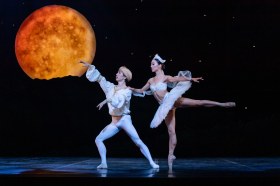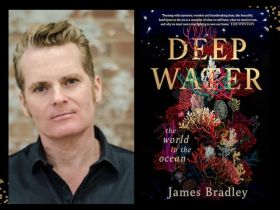Image via Shutterstock
“For last year’s words belong to last year’s language and next year’s words await another voice. And to make an end is to make a beginning.” – T.S. Eliot
The Australian National Dictionary Centre has announced their 2018 word of the year as “Canberra bubble”, referring to the idea that Federal politicians, bureaucrats and political journalists are obsessed with the goings-on in Canberra (rather than the everyday concerns of Australians).
While the arts sector has often been accused of also operating in its own bubble – or to use one of last year’s buzzwords, its own “silo” – 2018 has been less jargon-focused, with the most regularly used catchphrases this year indicative of strategic thinking and a more humane approach to our sector.
While 2017 served up a number of words that were hangovers from 2016, including disruptor, agency, leverage, amplify and silos, overall 2018 was about urgency, innovation, sustainability and being authentic.
We also became more comfortable with the tag “arts ecology” in 2018, which replaced the antiquated “art world”, however the rename hasn’t stuck in any stereophonic way.
So what has changed in 2018?
ArtsHub would argue that the tone has changed – this year’s rolled out buzzwords were less geared around technical innovation or hard-core management strategies and rather allowed a more humanitarian tone to enter our language. They were also words that simply offered better clarity.
These are the words that we at ArtsHub felt had the greatest traction and use this past year.
Buzzwords in the arts for 2018
1. Impact
Impact, impact, impact – that was the top word for 2018. We all wanted it, and we were all searching for ways to make it. The desire for our programming and strategic efforts to have maximum “impact” – to be felt by wider and broader audiences with more trackable outcomes.
2. Reach
Not dissimilar to impact in tone and the desire for greater doses of it – reach escalated in art world vocabulary in 2018 from a word that has been around forever, to an idea that would transform organsiations.
It has been described as the capacity and spread of an organisation to exert power at a distance.
3. Scaling
Another word that garnered some traction in 2018 was scaling, or scalability, which refers to the capability of an organisation to take on and effectively manage growth.
While this term really moved into the realm of fashionable words with start ups and the notion of ‘scaling your business’, for the arts it made a lot of sense in the last year as many arts organisations came off the back of recalibrating post-funding cuts, and the need to be more sustainable by scaling back what they do.
Unlike the term “growth”, scaling an organisation has more to do with preparedness of infrastructure to be ready for projected expanded activity.
4. Slow art
This was on last year’s list, however at ArtsHub we believe the slow art movement is on the rise.
In 2017, we were witness to an escalation in the authentic experience of viewing and making, and a striping back to basics. In 2018, we have taken that a step further from the making experience, and have attempted to live the wellness line and slow our considerations down – to be more holistic in how we plan, consider and embrace a cultural life.
5. Shoutocracy
pVI collective used this term in a new artwork with a social agenda they created this year – a gaming of new tactics for civil disobedience – and we love it at ArtsHub. Simply, who shouts the loudest gets the vote.
In a world drowning with opinions and social media trolling, the loudest voice often becomes the predominant position. But we all agree that this is far from favourable – so the rise of 2018 needs to be turned on its head. Let’s shout for accuracy; let’s shout for cultural intelligence in 2019.
6. Micro Commissions
We are all for the big gig, but sometime more can be done with successive smaller projects. Rather than pitch the big budget, big scale commission (which usually results in a big headache), arts organisations are increasingly turning to micro-commissions which are more appropriate in scale, resource management and achievable with budgets.
7. Scaffold
A word that has popped up often on the arts conference circuit in 2018 is “scaffold” – that is, how to provide support within a heightened platform or framework. Essentially it is about piggy-backing off and building upon the strength of an existing structure – using resources and shared networks to better position or amplify what you are doing.
It all comes down to knowing your network, and then working better with others. We will see a lot more of this moving into 2019.
8. Interrogate
While this one has been around for a while, much of the arts sector is angrier than ever – and in 2018 we seemed to want to interrogate everything with gusto.
The question should always be why, and within what context? As journalists for the arts it is in our DNA to interrogate our sector to ensure it is accountable, transparent and duly respected. As artists and cultural producers living in these unsettled times, there has been an increased activity around interrogating the social issues of the day in order to affect change. 2018 has been a year primed for such conversations.
9. UX
While this is one that has come from the tech world, UX – or User Experience – has flowed over into the arts and culture sector, as we have put increasingly more energy into visitor perception and engagement. Simply, we have to get the user experience right these days to remain sustainable and visible.
So that means: better web experience, more strategic social media, more diverse extended programming and outreach, and offering the capacity for your audience to comment. The future is about being in this together!
10. Blockchain
We’ve all heard the words blockchain, cryptocurrencies, bitcoin and ethereum (ETH) thrown around in the news and on social platforms. For the arts, such words have largely just washed over our sector until this year.
Referring to ‘a system in which records are maintained across several computers that are linked in a peer-to-peer network,’ Blockchain materalised this year as ArtChain Global – a digital platform that leverages secure blockchain technology to register, track, authenticate and trade art.
It has been developed by an Australian consortium of blockchain technologists and venture capital entrepreneurs, in partnership with Swinburne University of Technology in Melbourne.
Elsewhere in the world, countries such as Iran – which still operates with economic embargoes in place – have embraced Blockchain technology to enable artists and gallerists to reemerge on the international art market, and at art fairs.
Read: How ArtChain will revolutionise the art market
Read: Industry responds to ArtChain: is it all tech hot air?
Don’t be caught using
And the five words we have identified as being as stale as a bucket of prawns in the sun, are:
- Agency
- Unpack
- Portals and platforms
- Agitators
- Silos
And our prediction? In 2019, “governance” will be on the agenda with great urgency.
And in case you missed these:
Read: 10 buzzwords that dominated the arts in 2017
Read: 10 words not to use this year





